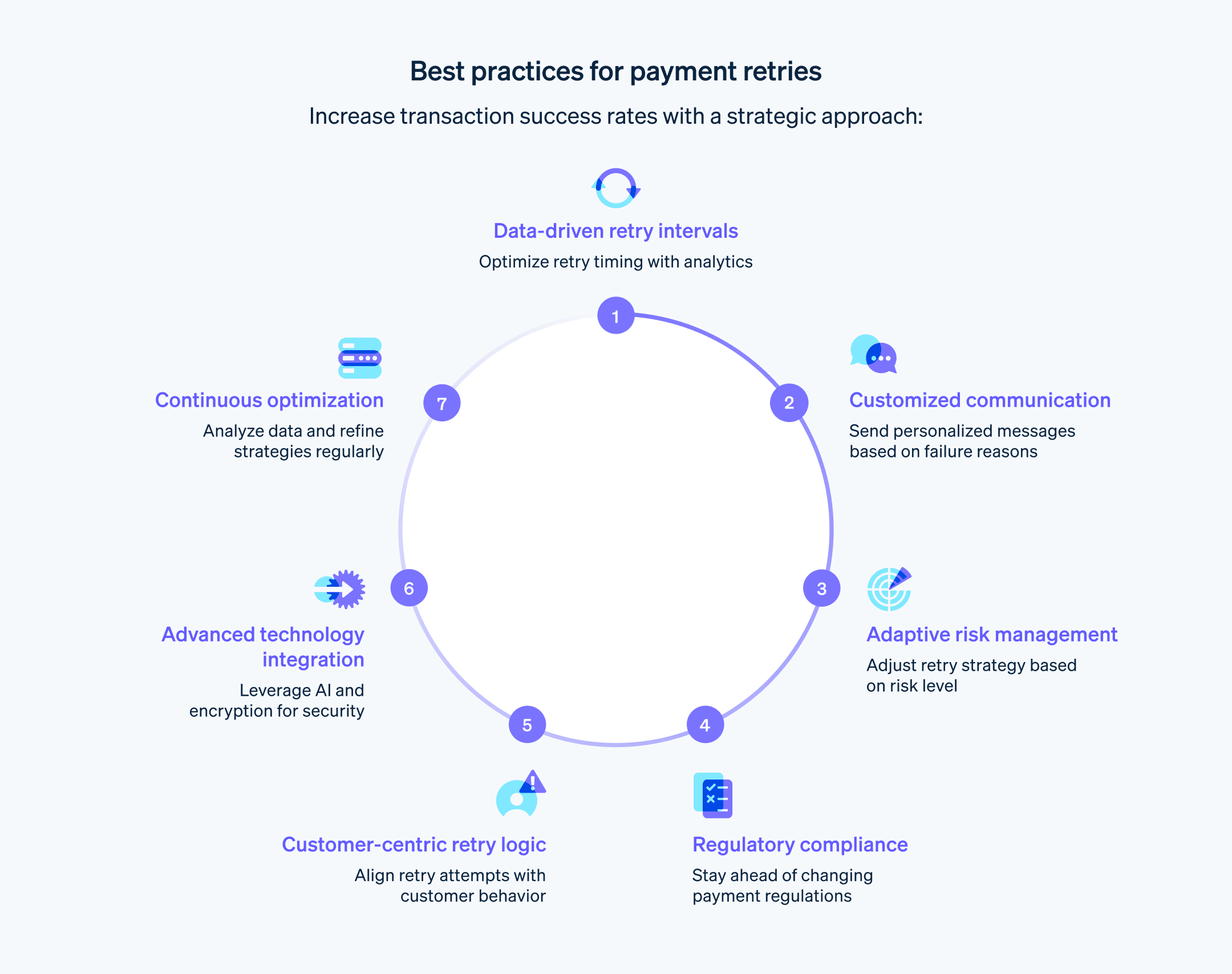付款重试是指企业在第一次尝试失败后,再次尝试处理付款。种情况在线上付款、订阅 和定期计费 模式中很常见。对于企业来说,付款重试的主要目的是成功完成交易,而不需要客户采取额外行动。
下面,我们将探讨支付失败的原因、付款重试的重要性,以及企业应采用哪些策略来成功重试付款。预计到 2027 年,全球支付市场的收入超过 3 万亿美元,因此企业有必要了解付款重试以及如何有效管理付款重试。以下是您需要了解的内容。
目录
- 为什么会发生付款失败的情况?
- 为什么付款重试是收入挽回的重要组成部分
- 如何进行付款重试?
- 企业在付款重试方面面临的挑战
- 付款重试最佳做法
- Stripe 能提供什么帮助
为什么会发生付款失败的情况?
付款失败的原因有很多。常见原因包括:
技术原因
系统中断:支付处理系统可能因技术问题、超载或维护而暂时中断。
网络问题:互联网连接不畅或中断可能会中断客户、企业和支付处理商 之间的通信。
软件错误:支付软件中的错误或故障可能导致不正确的处理和失败的交易。
安全漏洞:网络攻击和其他安全问题可能会危及支付系统并导致中断。
客户相关原因
资金不足:这是付款失败的最常见原因之一,尤其是经常性付款。
不正确的信息:错误地输入了银行卡详细信息(例如卡号、有效期或 CVV 代码 可能导致交易被拒绝。
过期的银行卡:尝试使用过期的银行卡将导致付款失败。
超过信用额度:如果客户超过其信用卡限额,发卡行就会拒绝交易。
欺诈活动:银行可能会拒绝可疑交易,以保护客户免受欺诈,即使这些交易是合法的付款尝试。
业务相关原因
过时的支付系统:使用过时或不兼容的支付系统的企业可能会遇到兼容性问题。
计费错误:不正确或不完整的账单信息可能会导致延迟或拒绝。
欺诈预防措施不足:薄弱的安全措施会使企业容易受到欺诈性交易的影响,从而导致拒付 和付款失败。
其他原因
为什么付款重试是收入挽回的重要组成部分
付款重试是企业挽回收入 和流失管理计划的关键。原因如下:
减少非自愿流失
付款失败通常会导致非自愿流失,即客户无意中放弃订阅服务,不是因为他们选择离开,而是因为支付障碍阻碍了他们续订订阅。通过重试失败的付款,企业可以解决这些问题,留住他们可能失去的客户。改善客户体验
简便的付款重试让客户无需重新输入付款信息或联系客户支持部门来解决付款问题。这一顺畅的流程节省了时间,减少了挫折感,从而带来更积极的客户体验。提高现金流的一致性
付款重试可从最初失败的交易中挽回收入,为企业提供更稳定、更可预测的收入流,从而在保持现金流一致性方面发挥重要作用。允许智能重试策略
分析付款失败的数据可以为智能重试策略提供依据。例如,了解成功交易的最常见时间或失败的典型原因,可以指导重试的后勤工作并提高成功率。将服务损失降至最低
对于采用订阅模式的企业来说,保持持续的服务是客户满意度的关键。付款重试有助于避免因付款失败而造成的中断,确保客户继续获得他们期望的服务而不会中断。降低运营成本
手动处理每笔失败的付款会占用大量资源。自动付款重试系统可减轻大量行政干预的需要,降低运营成本,使员工能够专注于更具战略性的任务。提高成功交易率
付款重试为企业提供了第二次处理交易的机会,提高了成功率,这是评估支付处理 系统财务健康状况和效率的关键。更大限度地提高客户的终身价值
客户终身价值 (CLTV) 是企业(尤其是采用订阅模式的企业)的一项重要指标。通过付款重试防止客户非自愿流失,企业可与客户保持长期关系,并最大限度地提高每位客户的收入潜力。适应多种支付方式
不同的支付方式具有不同的失败率和失败原因。企业可以开发定制的重试机制,以满足不同支付方式的具体要求和特点,使重试过程更加有效。确保法规遵从性
支付处理必须遵守一系列监管要求,这些要求可能因地区和支付方式而异。设计得当的付款重试机制会考虑到这些法规,从而确保合规性,最终避免潜在的法律和经济处罚。
如何进行付款重试?
根据支付系统的性质和支付失败的原因,付款重试有多种不同的方式。下面是详解:
基于失败原因
重试付款的方法通常取决于最初失败的具体原因。例如,如果付款失败的原因是资金不足,重试可能会安排在稍后的日期,给客户时间来纠正问题。相反,如果是技术性错误,重试可能几乎立即进行。时机策略
重试的时机很重要。有些系统使用固定的时间间隔,而有些系统则根据过去的交易数据和客户行为采用不同的时间间隔。例如,在清晨重试可能对某些特定人群更成功,因为这恰好是工资直接入账的时间。智能重试算法
先进的支付系统使用机器学习算法来分析过去的交易数据。这些算法可以预测重试失败付款的最佳时间和方法,从而提高成功的几率。这些算法会考虑交易记录、时间、支付方式乃至星期几等因素。多种支付方式
在客户拥有多种付款方式的情况下,一种付款方式的交易失败会自动触发另一种付款方式的重试。这减少了付款处理的延迟,提高了成功恢复的几率。客户通知
某些系统将客户通知集成为重试过程的一部分。这意味着客户会被告知支付失败和即将进行的重试,并可在需要时选择更新其支付信息。这种透明度可提高客户信任度,减少非自愿流失。合规性和遵守法规
付款重试必须遵守银行和金融法规,这些法规因地区而异。这包括遵守有关允许的重试次数、重试间隔时间以及客户通信要求的规则。可定制的重试限制
企业通常会对支付失败的重试次数设置限制,以避免客户产生挫败感和潜在的银行费用。这些限制通常可根据业务需求和客户档案进行自定义。不同行业的做法
不同行业在付款重试方面可能有不同的做法。例如,与一次性购买平台相比,订阅服务的重试计划可能更为宽松,这反映了其客户关系的持续性。回退程序
在重试持续失败的情况下,会启动回退程序。这些程序可能包括联系客户索取新的支付信息,或者在订阅服务的情况下,暂时停止服务,直到问题得到解决。与客户关系管理 (CRM) 系统集成
付款重试机制通常与 CRM 系统集成。这样,企业就能全面了解客户与企业的互动情况,从而制定个性化的重试策略,考虑客户的整体关系和对企业的价值。
企业在付款重试方面面临的挑战
在任何支付系统中,处理付款重试都可能面临许多挑战。以下是您可能面临的一些常见障碍以及如何克服这些障碍:
挑战:区分交易失败类型
在复杂的支付系统中,区分交易失败的类型可能很困难。故障可能包括网络宕机等简单问题,也可能包括多重身份验证 失败或信用额度问题等更复杂的情况。每种类型的故障都需要采取不同的策略,如果分类不当,可能会导致重试策略无效、运营成本增加和/或客户不满。
解决方案:高级诊断分析
利用机器学习实施先进的诊断分析,可以更准确地剖析交易故障并对其进行分类,帮助区分瞬时故障和持续故障类型,从而制定量身定制的重试策略并提高成功率。
挑战:优化重试算法
标准重试算法通常缺乏适应不同故障场景的灵活性。它们不考虑客户行为、交易类型或特定错误代码等变量。另一方面,不正确的重试间隔和频率会加剧故障率和操作效率低下。
解决方案:动态重试计划
开发一种可根据不同因素进行调整的动态重试算法,可提高成功交易的可能性。这种数据驱动的策略可以优化重试时间和频率,在成功率与运营成本和客户体验之间取得平衡。
挑战:重试中的法规遵从性和安全性
确保每次付款重试都符合不断变化的监管标准和安全协议是一项复杂但重要的任务。合规 和数字安全 的要求不断变化,要求企业持续更新流程。重试中的不合规或安全漏洞可能导致巨大的法律和声誉风险。
解决方案:持续的合规性监控和高级加密
实施持续的合规性监控和高级加密技术可确保重试既安全又合规。为了应对新出现的威胁和监管变化,有必要对这些系统进行定期更新和审计。
挑战:最大限度地降低付款重试的运营成本
付款重试会增加运营成本,重试过程中的人工干预,加上交易费用和客户服务查询的增加,会使这些成本迅速上升。既要有效管理这些费用,又要保持较高的重试成功率,这是一个微妙的平衡点。
解决方案:成本效益分析和流程自动化
对不同的重试策略进行全面的成本效益分析,可以找出最适合企业的策略。重试流程自动化可减少人工和相关成本,同时保持重试的一致性和准确性。
挑战:采用新的支付技术和方法
支付技术和方法的演变给支付系统的更新和兼容带来了挑战。如果不能快速适应新的支付方式,可能会导致交易损失和客户满意度降低。
解决方案:敏捷系统架构
构建敏捷的支付系统架构可以快速适应新技术。这涉及创建灵活的 API 和模块化系统组件,以整合新兴的支付平台和技术,确保系统保持相关性和高效性。
付款重试最佳做法
不同的收入挽回和催款管理策略之间可能存在大量差异。在制定企业的付款重试策略时,请遵循以下最佳做法:
数据驱动的重试间隔
使用高级分析来确定最佳重试间隔。分析客户付款模式、交易类型和历史成功率,以制定量身定制的重试计划。这种方法超越了一般的重试时间表,利用数据预测重试尝试的最有效时间,提高交易成功的可能性。定制沟通策略
制定与重试流程相一致的沟通计划。这涉及根据交易失败原因向客户发送定制消息。例如,如果付款失败的原因是银行卡过期,则应指导客户更新其支付信息。A/B 测试可帮助您完善这些消息,以确定哪些消息能引起客户群的共鸣。适应性风险管理
将动态风险评估模型纳入重试流程。该模型应评估与不同类型交易失败相关的风险,并相应调整重试策略。对于疑似欺诈等高风险情况,系统应自动将问题升级至人工审核或专门的欺诈检测 团队。法规遵从性
密切关注影响付款重试的全球和地区监管变化,并实施可自动更新以适应新法规的系统。这对于在不同司法管辖区之间存在监管差异的国际 企业尤为重要,而这一领域正在不断增长:2022 年,跨境支付规模达到 150 万亿美元,比上一年增长了 13%。以客户为中心的重试逻辑
在重试逻辑中贯彻以客户为中心的观点。这包括了解客户的偏好和行为,并根据这些偏好定制重试流程。例如,某些客户可能更喜欢在每月的特定日期或收到通知后重试。先进的技术集成
在支付处理和网络安全方面采用最新技术。这包括使用人工智能和机器学习进行预测分析,使用区块链进行安全交易记录,以及使用高级加密方法进行数据保护。掌握最新技术不仅可以提高重试过程的效率,还可以增强安全性和客户信任度。持续优化流程
定期审查和优化付款重试流程。这应该是一项持续的工作,包括监控性能指标和客户反馈。利用这些洞见来完善您的战略,并适应不断变化的市场条件和客户需求。

Stripe 能提供什么帮助
Stripe 具有内置功能,企业可利用这些功能创建简化的战略,以解决收入挽回、催款管理和付款重试等问题。以下是 Stripe 可以提供的帮助:
自动重试逻辑
Stripe 的自动重试逻辑 旨在优化付款重试的时间和频率。该系统使用机器学习来分析历史付款数据,帮助确定重试失败付款的最佳时间,从而增加成功收款的机会,同时减少不必要的尝试。智能催款工具
Stripe 提供高级催款工具,企业可以根据特定需求进行定制。当付款失败时,这些工具会自动向客户发送通知,提醒他们更新支付信息。企业可以配置 Stripe 的催款系统,在特定时间间隔通过电子邮件或短信等不同通信渠道发送这些提醒。可定制的结算周期
使用 Stripe,您可以定制计费 周期和重试时间表,以适应不同的客户群。这种灵活性可让您采用更适合自身的收款方式,对于订阅模式或拥有不同客户群的企业尤其有用。实时分析和报告
Stripe 提供全面的分析和报告功能,提供对支付交易的实时洞察。这包括有关付款失败、重试成功率以及客户对催款工作的反应的详细报告。这些分析对于不断完善和改进收入挽回策略非常重要。合规性和安全性
Stripe 遵守最高的合规性和安全性标准,确保付款重试和催款工作安全且符合法规要求。Stripe 遵循支付卡行业数据安全标准 (PCI DSS),并采用先进的加密方法来保护敏感数据。与 CRM 和会计软件集成
Stripe 的平台可以轻松与各种 CRM 和会计软件集成,从而促进连贯的收入挽回和催款管理策略,使客户数据和财务记录保持同步和最新。自定义规则和机器学习模型
企业可以在 Stripe 平台上创建用于付款重试和催款管理的自定义规则。此外,Stripe 的机器学习模型可在潜在支付问题发生前进行预测和识别,从而采取积极措施防止收入损失。全球支付方式和货币
Stripe 支持多种支付方式 和超过 135 种货币,是拥有全球客户群的企业的理想选择。这保证了付款重试尽可能具有包容性和适应性,满足不同地区客户的首选支付方式。
本文中的内容仅供一般信息和教育目的,不应被解释为法律或税务建议。Stripe 不保证或担保文章中信息的准确性、完整性、充分性或时效性。您应该寻求在您的司法管辖区获得执业许可的合格律师或会计师的建议,以就您的特定情况提供建议。